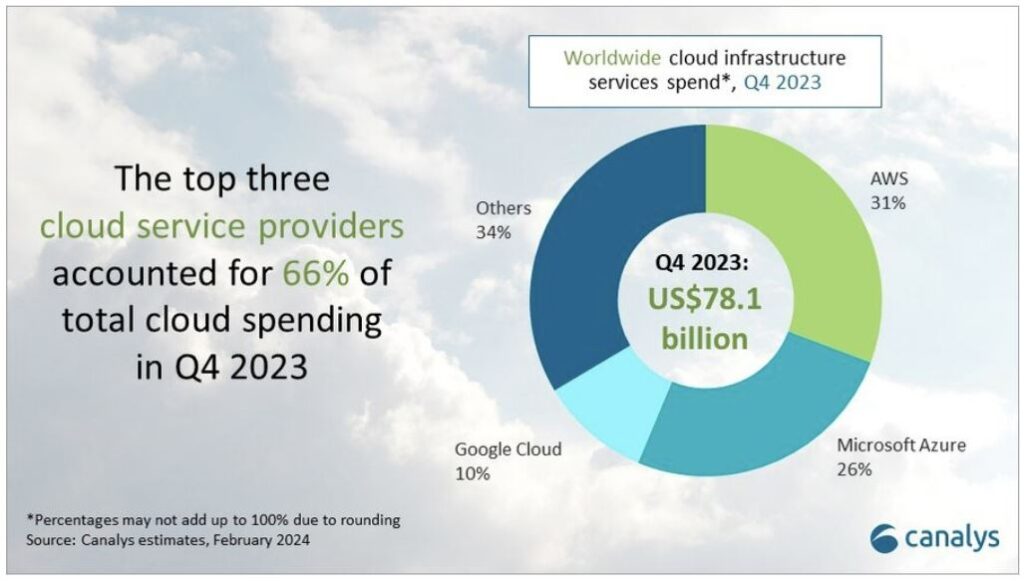In the fourth quarter of 2023, the global expenditure on cloud infrastructure services witnessed a remarkable 19% year-on-year growth, reaching a total of $78.1 billion, according to a report by Canalys. The entire year of 2023 saw 18% increase in total spending on cloud infrastructure services, amounting to $290.4 billion, compared to $247.1 billion in 2022.
The traditional influence of enterprise IT optimization on the cloud services market is dwindling, with a noticeable shift as more customers expand their commitments with hyperscalers to meet the anticipated surge in consumption requirements. Cloud migration efforts are gaining momentum once again, particularly driven by a surge in new demand, especially in the widespread adoption of Artificial Intelligence (AI) applications.
Hyperscalers are actively increasing their investments in generative AI, anticipating that leveraging its capabilities will unlock new opportunities in cloud consumption. Canalys predicts a 20% increase in global cloud infrastructure services spending in 2024, surpassing the 18% growth observed in 2023.
In the fourth quarter of 2023, the top three cloud providers—AWS, Microsoft Azure, and Google Cloud—experienced a collective growth of 21%, capturing a significant 66% share of the total spending. Both Microsoft Azure and Google Cloud reported impressive revenue growth rates exceeding 25%, contributing to Microsoft’s significant 30% growth and narrowing the gap with AWS.
While AWS witnessed a modest uptick in growth, with a 13% year-on-year increase, it still lagged behind the growth trajectories of Microsoft Azure and Google Cloud. Analysts attribute AWS’s slower growth to its comparatively delayed advancements in AI.

Amazon Web Services: In the fourth quarter of 2023, Amazon Web Services (AWS) maintained its dominance in the cloud infrastructure services market, capturing 31% of the total expenditure. AWS’ backlog reached US$155.7 billion, reflecting a substantial year-on-year increase of over US$45 billion. The upward trajectory of AWS’ growth rate is expected to continue throughout 2024.
In December 2023, AWS strategically reduced its AWS Marketplace listing fees for SaaS and data offerings from 13% to 3%, aligning with competitors Microsoft Azure and Google Cloud. This move emphasizes AWS’ focus on the marketplace as a facilitator of consumption and partner revenue rather than a standalone revenue-generating asset.
Azure: Microsoft Azure, the second-largest cloud service provider, increased its market share to 26% in Q4 2023, up from 23% in Q4 2022. The surge in AI adoption played a pivotal role in Azure’s impressive 30% revenue growth compared to Q4 2022. Azure continued to enhance its AI capabilities by expanding support for OpenAI’s latest models and introducing fine-tuning capabilities. With a significant base of 53,000 Azure AI customers, Azure’s growth momentum is expected to persist, supported by the availability of Copilot for Microsoft 365 across all sales channels.
Google Cloud: The third-largest provider, Google Cloud experienced a 26% growth in Q4 2023, securing a 10% market share. Fueled by the demand for AI, Google Cloud embarked on a new growth trajectory during this period. As of December 31, 2023, Google Cloud accumulated a revenue backlog of US$74.1 billion. Google aims to solidify its position in the artificial intelligence industry with the Gemini large language model. Just two months after its launch, Google announced the successor, Gemini 1.5, in February 2024, targeting developers and enterprise users, with plans for a broader consumer launch soon after. Google Cloud has also tripled its number of co-sell deals with partners since 2022, emphasizing its commitment to expanding channel partnerships for continued growth.








